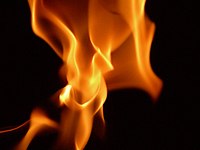
Photo from wikipedia
Abstract In this study, the mechanisms of the chemical, thermal and dilution effects of the CO2, H2O, N2 and EGR quantitatively analyzed on the laminar flame speed, laminar flame structure… Click to show full abstract
Abstract In this study, the mechanisms of the chemical, thermal and dilution effects of the CO2, H2O, N2 and EGR quantitatively analyzed on the laminar flame speed, laminar flame structure and key radicals profiles of the premixed methane/air mixture. Moreover, the artificial species of the FCO2, FH2O, FN2 and FEGR were used to separate the combined chemical and physical effects. Furthermore, the impacts of the hydrogen enrichment coupled with the EGR on the laminar flame speed, the laminar flame structure and key radicals profiles of the premixed methane/air mixture was also studied in detailed. The results indicated that the chemical effect of the CO2 dilution gas produced the greatest impacts on the laminar flame speed, adiabatic combustion temperature and key radicals formation of the methane/air, and followed by the H2O vapor, EGR and N2. In addition, the dilution limitation of the CO2 in the methane/air was smallest, followed by the H2O vapor, EGR and N2. Moreover, the thermal effect of the CO2 in the methane/air was strongest due to its highest specific heat capacity, followed by the H2O vapor, EGR and N2. The laminar flame speed and adiabatic combustion temperature of the methane/hydrogen/air increased with increasing the hydrogen. Furthermore, the lean-burn limitation of the methane/air was extended with the increase of the hydrogen. The radical pool, such as H, O, OH, accelerated the chain branching reactions and the chain propagation reactions, and thereby increasing the effect of the chemical amplifier during the combustion of the premixed methane/air mixture.
Journal Title: Fuel
Year Published: 2020
Link to full text (if available)
Share on Social Media: Sign Up to like & get
recommendations!